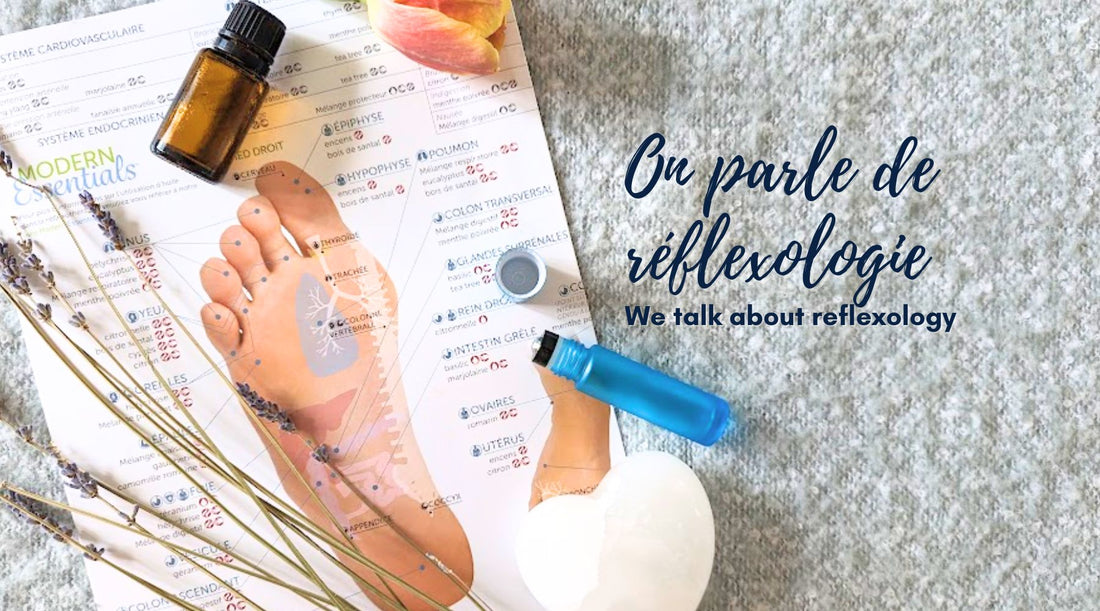
Discover the power of reflexology and essential oils
Share
Reflexology is a fascinating practice that is based on the idea that specific points on the feet and hands are connected to various parts of the body. Although learning reflexology can take time, understanding its basic principles can already offer you effective ways to manage your personal well-being or that of your loved ones. Let's find out together how to get started with this ancient technique, and how our Reflexology Charter can help you navigate and apply these concepts in your daily life or with your clients.
What is reflexology?
Reflexology involves applying pressure to specific points on the feet, hands, and sometimes the ears. Each point is a window into a specific organ or bodily function. By stimulating them, you can reduce pain, promote relaxation and even improve blood circulation.
How reflexology works
This practice sends signals that can help balance the nervous system and release endorphins, reducing pain and stress. It is a complementary method appreciated for its non-invasive and soothing approach.
Who uses reflexology?
- Health professionals: Many therapists, including massage therapists, naturopaths and alternative medicine practitioners, integrate reflexology into their service offering for a holistic approach to health.
- People Seeking Natural Relief: Many turn to reflexology to manage conditions such as stress, insomnia, and chronic pain, appreciating its ability to improve well-being without medication.
The Reflexology Charter: Your essential guide
This charter is a key tool for anyone, professional or amateur, wishing to apply reflexology precisely and effectively. She offers :
- Information based on Modern Essentials 10th Edition , including the best essential oils and blends for every reflex point.
- A practical double-sided design for easy use during consultations or workshops.
- Oil and water resistant construction, ensuring maximum durability.
Roll-on applicator recipe for digestion
- 10 ml carrier oil (such as fractionated coconut oil or sweet almond oil)
- 5 drops of Basil essential oil (promotes healthy digestion and calms intestinal spasms)
- 3 drops of Marjoram essential oil (soothing and relaxing properties)
- 2 drops of Geranium essential oil (helps regulate various body systems including the digestive system)
Instructions :
- Add the carrier oil to your 10ml roll-on applicator.
- Then add the drops of essential oils.
- Close the applicator and shake it well to mix the oils evenly
Application in reflexology on the hands: The reflexology point for digestion is mainly located on the palms of the hands, specifically in the area which corresponds to the stomach and intestine.
Here's how to do it: Locate the reflexology point for the stomach and intestines on your palm. According to the reflexology chart, it is generally located just below the pads of the fingers, towards the center of the palm.
Use the roll-on applicator to apply the oil directly to this spot. Gently massage the area with the applicator in small circular motions for 1-2 minutes. This can be repeated several times a day, particularly before or after meals for better digestive comfort.
Additional Tips: Reflexology can be used regularly to help maintain a healthy digestive system. In addition, you can also apply this mixture around the navel and along the abdomen to maximize the digestive benefits*.
Conclusion: Whether you are a representative wishing to enrich your support methods or simply looking for natural ways to support your health or that of your family, reflexology and our reflexology charter are essential. Explore the potential of this ancient practice with the Reflexology Charter 10th edition and discover how it can benefit your life or professional practice.
* Important Disclaimer:
Responsible use of essential oils and reflexology: Reflexology and essential oils offer many wellness benefits, but it is essential to understand that these approaches are used for general support and comfort and should not be considered such as treatments or cures for medical conditions. If you have specific health concerns, always consult a qualified healthcare professional before beginning any new wellness regimen.
Skin test: Before using a new essential oil, always perform a skin test to check for possible allergic reactions. Apply a small amount of the diluted oil to a small area of non-sensitive skin, such as the inside of the arm, and wait 24 hours to observe any adverse reactions.
Photosensitivity with citrus oils: Citrus essential oils such as lemon, bergamot, grapefruit, and others can be photosensitizing. This means they can make the skin more sensitive to the sun and potentially cause burns or other reactions when exposed to UV light. Avoid exposure to sunlight or UV lamps for 12 to 48 hours after applying these oils to the skin.
Use with caution: Always dilute essential oils with an appropriate carrier oil before skin application to minimize the risk of irritation or reaction. Follow dilution recommendations provided by reliable sources or qualified healthcare professionals.
